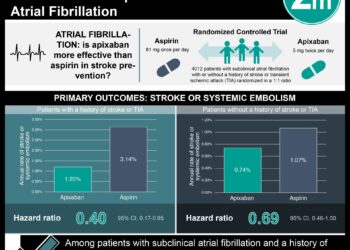Aspirin alone likely safest antithrombotic therapy after bioprosthetic aortic valve replacement
1. Aspirin combined with warfarin was linked with increased bleeding but not less thromboembolism compared with aspirin alone after bioprosthetic aortic valve replacement.
2. Dual antiplatelet therapy showed a non-significant trend towards increased bleeding but no less thromboembolism compared with aspirin alone after bioprosthetic aortic valve replacement.
Evidence Rating Level: 2 (Good)
Study Rundown: Bioprosthetic aortic valve replacements (bAVR) have become more commonly performed over the last two decades. One of the most feared postoperative complications is thromboembolism. Currently, guidelines vary regarding optimal antithrombotic therapy for these patients. In this large, retrospective cohort study involving almost exclusively male patients, aspirin plus warfarin was linked with higher rates of bleeding events at 90 days however no less thromboembolism or all-cause mortality when compared with aspirin alone after bAVR. Dual antiplatelet therapy showed a similar pattern however the increased rate of bleeding did not reach statistical significance.
The large sample size supports this study’s findings, however the almost entirely male population is a significant limitation in generalizing the findings to female patients. Furthermore, as aspirin is available over the counter, it is possible that the rates of aspirin use were underestimated. Finally, although thromboembolism risk is highest post-operatively, the follow-up period was short and it is possible that differences may have emerged in the longer term.
Click to read the study in JAMA Surgery
Relevant Reading: High risk of thromboemboli early after bioprosthetic cardiac valve replacement
In-Depth [retrospective cohort]: This was a retrospective cohort study using data from the Veterans Health Administration (VHA) using text mining of notes for patients with bioprosthetic aortic valve replacements (bAVR) performed between 2005 and 2015. The primary intervention was antithrombotic therapy post bAVR split into aspirin plus warfarin, aspirin only, dual antiplatelet therapy, no antithrombotics, other only, and warfarin only. Multivariate modelling with propensity scores was used to adjust for differences (including history of atrial fibrillation) in the three most common strategies; aspirin alone, aspirin plus warfarin, and dual antiplatelet therapy. Aspirin alone was used as the reference category. VHA and non-VHA pharmacy data was used to assess antithrombotic strategy. Primary outcomes (measured at 90 days) included all-cause mortality, thromboembolism risk (myocardial infarction, acute coronary syndrome, ischemic stroke, pulmonary embolism, or peripheral arterial embolism), and bleeding events (gastrointestinal, intracranial, genitourinary, retroperitoneal, and pulmonary) using primary diagnosis codes from emergency department visits or hospital admissions.
There were 9060 patients in this cohort, notably 98.6% were male. Patients with prior major bleeding were less likely to be prescribed aspirin or warfarin after bAVR. Aspirin alone was the most common strategy (48.6%), followed by aspirin plus warfarin (18.1%), no antithrombotics (16.0%), warfarin alone (4.8%), and other (3.1%). There was no difference in all-cause mortality at 90 days, with aspirin alone at 1.3%, aspirin plus warfarin at 1.6%m and dual antiplatelets at 1.2%. There was no difference in thromboembolism at 90 days, with aspirin alone at 1.5%, aspirin plus warfarin at 1.7% , and dual antiplatelets at 1.9%. Aspirin plus warfarin was more likely to cause bleeding events at 90 days at 2.8% (aOR 1.92, 95% CI 1.17-3.14, p=0.01) compared with aspirin alone at 1.1%. Dual antiplatelet therapy showed a non-significant trend towards more bleeding events compared with aspirin alone (aOR 1.86, 95% CI 0.95-3.63, p=0.07).
Image: PD
©2018 2 Minute Medicine, Inc. All rights reserved. No works may be reproduced without expressed written consent from 2 Minute Medicine, Inc. Inquire about licensing here. No article should be construed as medical advice and is not intended as such by the authors or by 2 Minute Medicine, Inc.







